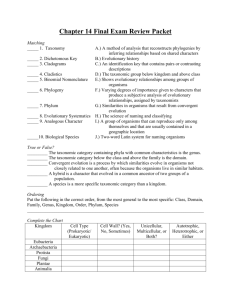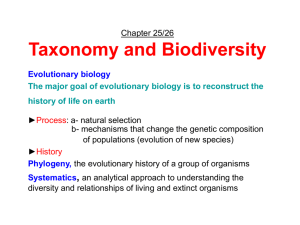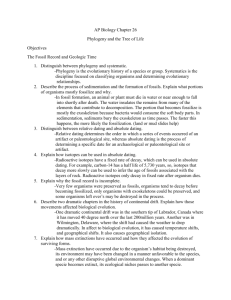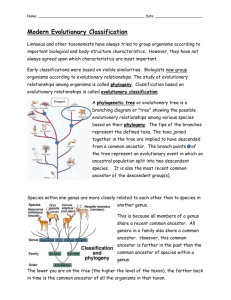CLASSIFICATION and TAXONOMY
advertisement
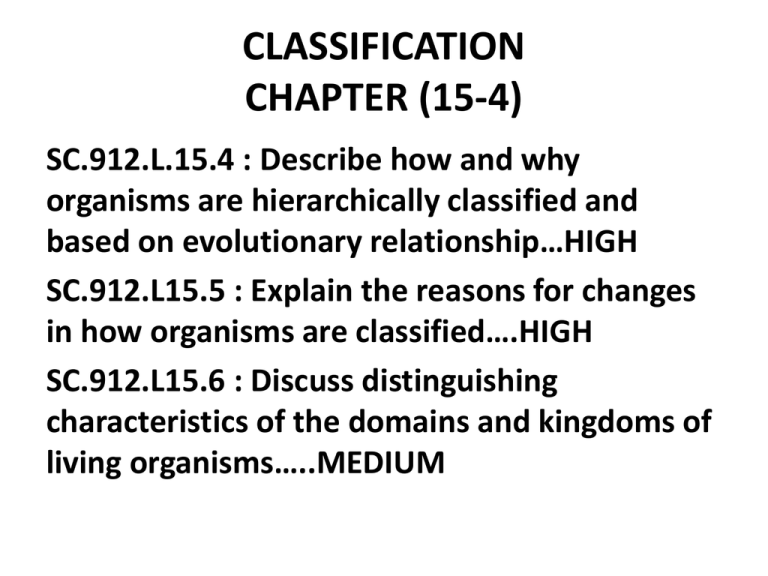
CLASSIFICATION CHAPTER (15-4) SC.912.L.15.4 : Describe how and why organisms are hierarchically classified and based on evolutionary relationship…HIGH SC.912.L15.5 : Explain the reasons for changes in how organisms are classified….HIGH SC.912.L15.6 : Discuss distinguishing characteristics of the domains and kingdoms of living organisms…..MEDIUM A. DOMAINS AND KINGDOMS • A domain is a taxonomic category above the kingdom level. It’s a new scheme that recognizes 3 domains: 2 domains of prokaryotes and 1 of eukaryotes. • PROKARYOTES: 1.bacteria: differ from archea in cell structure and chemical make up. Figure 16-8 p.361 • 2. archea: from Greek meaning “ancient”. Live in xtreme environments, may resemble conditions in early earth. Thermophiles, halophiles. Etc. p.361. • EUKARYOTES: fungi, plants, animals, protozoans. • 6 kingdoms vs. 5(old system) DRAW fig. 15-32. p.348 • 1. SYSTEM OF CLASSIFICATION: What is taxonomy?? It is a branch of biology that involves the naming and classification of species. Assigning scientific names to species is an important part of studying the history of life. WHY?? Because common names can cause confusions. Also, scientists around the world can speak the same language and understand each other. 2. REVIEW OF LINNAEAN SYSTEM OF CLASSIFICATION AND BINOMIAL NOMENCLATURE. • The system most widely used dates back to Swedish Botanist Carolus Linnaeus (1707-1778). The system has a 2 part Latin name ( BINOMIAL) for each species: genus and species. • The first part of the binomial name is the genus (plural genera) to which species belong. • The second part refers to ONE species within the genus. • Ex. Panthera pardus (leopard) Only the first letter of the genus is capitalized and the whole binomial is italicized • Panthera leo ( Lion). Taxonomist place same genera into families, similar families into orders, orders, etc • • • • • • • • • • • Taxonomic classification of humans Kingdom….Animalia Phylum……Chordata Sub-phylum…..Vertebrata Class……Mammalia Order…..Primates Family…..Hominidae Genus …..Homo Species…..sapiens DRAW FIGURE 15-24 PAGE 342 (you don’t have to draw the animal if you don’t want to, but write the name instead) • B. HIERARCHICAL CLASSIFICATION • 1. CLASSIFICATION AND EVOLUTION. Darwin viewed Linneaus’s system of classification in the context of evolution. He wanted to show the relationship between classification and evolution. A diagram that reflects the hypothesis of evolutionary relationships has a branching pattern called a PHYLOGENETIC TREE. (phylogeny means evolutionary history). • The greater the number of homologous structures 2 species have the more closely the species are thought to be related. • Example: The skull of chimpanzees and humans are not single bones but a fusion of many bones. The 2 skulls match almost perfectly bone for bone. P.344 • DRAW FIGURE 15-25 • 2. MOLECULAR DATA AS A TAXONOMIC TOOL • Relatedness of species can be measured by comparing their genes and gene products (proteins). The more the sequences math up the more closely the species are related. A strong support for such hypothesis is when the molecular data agrees with other source such anatomy. Example; fossils and molecular data coincide in explaining the relatedness between hippos, cows, deer, whales and pigs. • READ FIGURE 15-27 3. CLADISTICS • Cladistics is the scientific search for ancestral relationships between species and how they are classified to demonstrate evolutionary commonship. (clade = branch) • Example: figure 15-28 (DRAW IT PLEASE). It shows two simple cladograms which are phylogenetic trees. IDENTIFYING CLADES 1. Each branch is a clade. It is like a taxonomic level in classification and can exist within larger clades. 2. Example: figure 15-29..draw it plse!! Species B through H are members of on clade (yellow). Species I through K (orange). They are part of a larger clade (blue). Species A is the ancestral species. • DERIVED CHARACTERS • All of the organisms in particular clade share derived characters (homologous characteristics that unite the organisms as a group). DRAW FIGURE 15-30. • Examples: HAIR: the horse, wolf, leopard, house cat. • TEETH ADAPTED FOR EATING MEAT: wolf, leopard, and the house cat. • ABILITY TO RETRACT THEIR CLAWS: leopard and house cat. • C. WHY THESE CLASSIFICATIONS CHANGE?? P.346 REVIEW OF ANIMALS A. Characteristics of Animals • 1. Multicellular organisms: made of 2 or more cells. Ex. Animals, plants, fungi and some protists. • 2.Heterotrophic : organisms that do not make their own food. • 3. Eukaryotic: cells that have a membrane bound nucleus. EX: Fungi, animals, plants, and protozoans. • 4. Homeostasis: Read p.593. The ability of our bodies to buffer changes in the external environment providing a relative internal environment. This internal stability is called homeostasis. Crucial due to our narrow range of conditions. (CH27 SEC.3) • Set points for example are normal levels at which our bodies operate. • The brain turns switches on and off that will maintain homeostasis. Ex :shivering and sweating. Muscles release heat when you are cold and sweating cools the body. • Also, hormones are released to help maintain homeostasis. • Excretion of body waste. • ACTIVITY 27-3..IMPORTANT!!! B. Evolutionary Body Plans** • 1. Symmetry: a. radial symmetry, can be divided in many planes ex. Hydra. (b). Asymmetry: sponges, sessile organisms(not moving) no symmetry or irregular shape. (c) bilateral symmetry: can be divided down its length into similar right and left halves. Can only be divided along one plain. • 2. Germ layers: ectoderm, endoderm, mesoderm. • From zygote to embryo (once cell division has started) and in the early stages forms a blastula (5 days in humans) then a gastrula. Layers of cells lining the outside are called ECTODERM cells. They develop into the skin, and nervous tissue of the animal. • ENDODERM cells will develop into the lining of the digestive tract and organs associated with digestion. . THE MESODERM cells is the third layer found between the endoderm and ectoderm and they will develop into the muscles, circulatory system, excretory system and in some animals the respiratory system. • 3. Body Cavity : fluid filled spaces inside their bodies in which internal organs are found. It allowed animals to grow larger because supports organ systems • 4. Segmentation: is found in segmented worms. Important adaptation for movement because every segment has its own muscles allowing movement. • 5. Cephalization: ex. Squid and actopi • 6. Limbs: tetrapods, arthropods. • C. Evolutionary Diversity • 1. Invertebrates : Animals without a backbone. They make up app. 95% of the different kinds of animals on earth. Most live in aquatic or moist terrestrial habitats. Most of the aquatic species live in marine waters. Ex: sea stars, jellyfish, snails, clams, insects and worms. • 2. Vertebrates : animals with backbones, are well represented in terrestrial habitats, but also live in marine and freshwater. Ex. Fishes, frogs, snakes dogs, ryan, michael, sarah, etc. • DRAW FIGURE 17-20 PAGE 397. CHAPTER 17 SECTION 5 •
